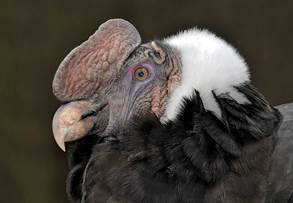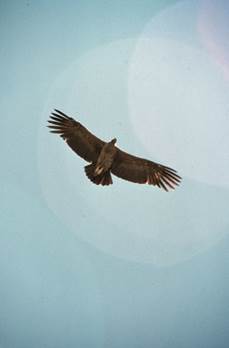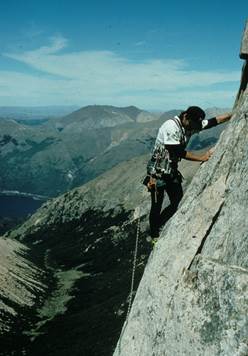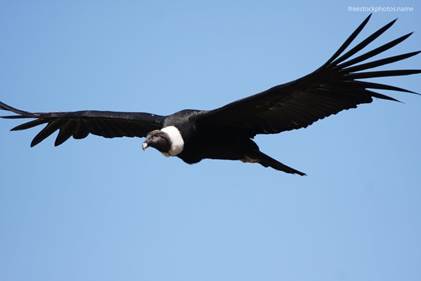This is one big bird, with a maximum wingspan of 10 ft. 6 in., which is the largest of land birds and fourth in the world only behind two species of albatross and two species of pelican. The Andean condor inhabits the Andes of South America stretching from Venezuela and Colombia through Ecuador, Peru, Chile, Bolivia, and western Argentina to Tierra el Fuego. Its range has been reduced by humans and it is considered rare in Venezuela and Colombia.
The condor’s habitat includes open grasslands and alpine areas up to 16,000 ft. and it prefers open, non-forested mountain terrain but it also inhabits lower level beech forests in Patagonia. Males weigh up to 33 lbs. and females up to 24 lbs., which explains why they need such large wings to keep them aloft. Recently published data indicate that Andean condors have the greatest average weight of any living flying bird, including trumpeter swans. Here’s a short video of birds in flight: http://www.bing.com/videos/search?q=andean+condor&qpvt=andean+condor&FORM=VDRE#view=detail&mid=29E703B4336E1E88F07629E703B4336E1E88F076
Adult plumage is a uniform black with a frill of white feathers around the base of the neck, and large patches or bands of while on the wings that do not appear until after the first molt. The head and neck are red to blackish and lack feathers, suitable to sticking ones head into carcasses and not worrying about matted head feathers. These birds earn their living by soaring on thermals and searching for carrion. It’s also thought that the lack of head feathers and exposure to the ultraviolet light at high altitudes facilitates sterilizing/dehydrating any bacteria picked up while feeding on carrion. The male has a red comb, or caruncele atop his head and the skin of the neck lies in folds forming a waddle – both of which flush with a heightened emotional state. The male iris is brown while the female’s is deep red. The condor lacks eyelashes.

Andean condors have an elongated middle toe with a mildly developed hind toe with straight and blunt talons, thus their feet are more adapted to walking than grasping. Speaking of their feet – condors exhibit urohidrosis – often emptying the contents of its cloaca (common opening for reproductive/waste) onto its legs and feet, which has a cooling, evaporative effect. Oddly, this doesn’t seem to make much sense because the condor inhabits cold, high elevation areas. Its legs are often streaked with white from the buildup of uric acid from this habit – which is also common among New World vultures, indicating it may be a remnant behavior from ancestors that inhabited lower elevations.
The word condor is derived from the Quecha word kuntur. Quecha is the language of the Inca and widespread in South America. Aymara, the other common indigenous language, is from the people not subsumed by the Inca culture. The genus Vultur from the Latin for vulture and the species, gryphusfrom the Greek grupos for hook-nose.

Sexual maturity does not occur until the condor is five or six years old and in the wild birds may live up to 50 years. Captive birds have lived to 79 years. Nests are a simple pile of sticks laid on an inaccessible cliff ledge. One or two eggs are laid during February or March every other year. Eggs are incubated by both parents and hatch in about 56 days. Birds fledge after six months but will continue to roost and hunt with their parents until age two when their parent’s attention turns to the new clutch.Condors are not picky eaters and their diet includes llamas, alpacas, rheas, guanacos, deer, armadillos, cattle, horses, mules, sheep, pigs, goats, dogs, etc., etc.
In indigenous Andean religions the condor is revered as a symbol of power and health and that its bones and organs possess medicinal powers. In La Paz, Bolivia, I purchased five small clay icons from an old woman in the market who touched each in the palm of my hand describing their trait – tapping the condor she nodded and said “valor” (courage).
I first remember condors from an episode of Jonny Quest, which I watched regularly on Saturday mornings with my siblings, in the episode Shadow of the Condor. You can watch the whole episode here or just the trailer at the beginning, which shows the trusty dog companion, bandit, narrowly escaping getting picked off by a condor (which we know now as unlikely due to their foot/talon anatomy!). https://www.youtube.com/watch?v=DKhQg-GvynE
Back in the early ‘90s I spent two months climbing in Patagonia and first got to see the real deal. We had seen them regularly but from afar the first month in Southern Patagonina. Later, near San Carlos de Bariloche, Argentina my buddy Dick and I were off to climb the tower Torre Principal and we spotted several condors on the approach, soaring around or perched high on ledges. Up on the tower and leading a steep pitch, about 100 ft. above Dick and the belay ledge I heard him bellow loudly – CONDOR! – I looked down and over my shoulder to see a condor cruising along cliff face, wing tips almost brushing the granite 20 ft. below me. Whoa! That is a big bird!
On the next few pitches the standard warning became CONDOR ALERT! as the birds seemed oblivious to us, or maybe just pitied our relatively slow approach to the top of the tower. We tagged the summit in the fading light and started the long series of rappels back to camp, leaving the peak to its more graceful inhabitants.

